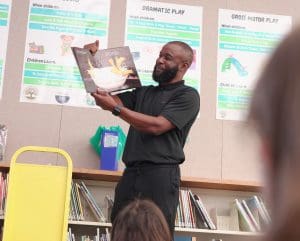Anytime when family and friends gather and chat- you might feel the need to spruce up your storytelling skills.
Jennifer Bacall, a youth literacy librarian, has put together the tips you'll need to help entertain your listeners.

Hints to read to a group:
-
Know your audience. If you are reading to young children choose materials that have short and snappy sentences and silly or relatable experiences.
There is a reason that kids gravitate to Pete the Cat and Mo Willem’s pigeon books. -
Read the material first. Memorization isn’t necessary, but if you are already comfortable with the flow of the sentences and have practiced how you
would like to read them your presentation will naturally gain credibility as a storyteller. -
Read with expression. Some books are written with obvious accents on words in the text, others have multiple characters speaking.
Take advantage of these textual cues to add layers to your narration. Adjectives and adverbs are effective words to stress.
Don’t be afraid to make faces, use your hands and make sound effects too.
Hints to telling a story in the oral tradition:
-
 Give eye contact. One benefit of telling a story in the oral tradition is that you can interact with the audience. Look at them and notice what they react too.
Give eye contact. One benefit of telling a story in the oral tradition is that you can interact with the audience. Look at them and notice what they react too.
You can delete portions of the story when they seem bored or add more humor if they react the most strongly to the funny parts. -
Pay attention to your pacing. Pacing should vary while storytelling. A slower or faster pace can intensify a dramatic scene.
Characters can speak at different paces and with different cadences. This will keep the experience fresh and not predictable. -
Avoid the moral of the story finishes. Not only is this a dated form of storytelling, it tells the listener what to think.
A better ending to that style of story is to engage them with the story. Ask them what they think of the events and characters' actions and allow them
to discover the moral on their own.

Hints for all methods of storytelling
- Use a strong and confident voice. If you seem confident with the work that you’re presenting, people will naturally be drawn into the story. They are also more likely to pay complete attention.
- Take time to prepare. Like most things, storytelling ability improves with practice. If possible, practice on family, friends or colleagues. You will be able to notice which parts of the story to emphasize and which parts to zip past.
- Tell a story that is meaningful to you. If you try to read a book that you don’t enjoy or tell a story that you don’t connect with, chances are it will be obvious to your audience. If you have trouble finding a story for a specific group ask for help. There is a bounty of materials, all easily accessible that can suit almost any situation, its very likely that other colleagues can suggest titles for you.
Watch below as she gives you a sample of exactly what it sounds like!



Add a comment to: How to Perform a Great Story Time